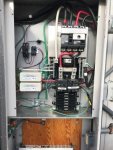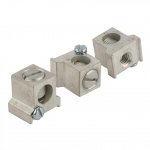chicagosparky
Member
- Location
- Chicago, IL
Have a telecommunications client that has numerous sites wanting us to add a relay in their cabinets for a power loss alarm notification means. Their existing cabinets have a 200A, single phase MCB which is fed with 3/0 CU conductors. They are asking us to put a #14 in parallel with each of the feeder conductors and run it over to a new 15 A CB & new relay we install inside the cabinet as shown below. They provided us with these diagrams.
Even though the #14 will only be ran approx. 18 inches inside the cabinet to a 15 amp CB, the tap rule would not apply here & still unable to put a 2nd wire under one lug. Is this a correct assumption?


Even though the #14 will only be ran approx. 18 inches inside the cabinet to a 15 amp CB, the tap rule would not apply here & still unable to put a 2nd wire under one lug. Is this a correct assumption?



